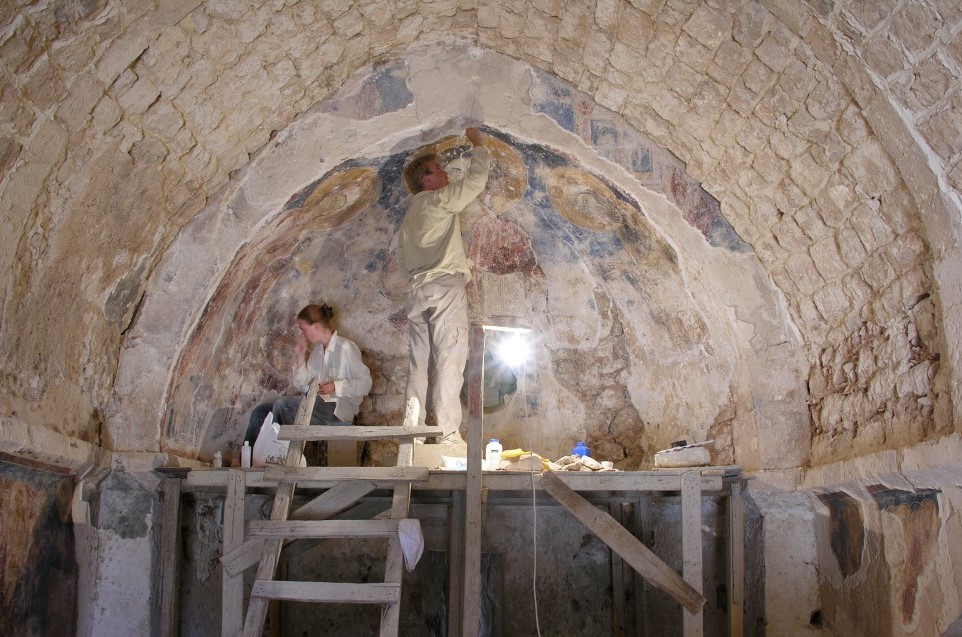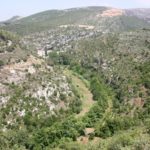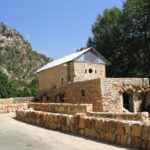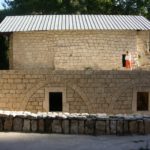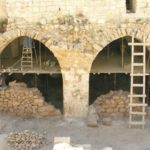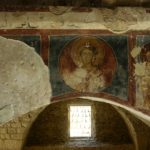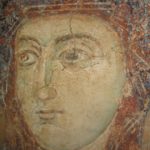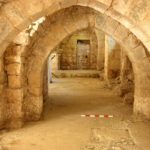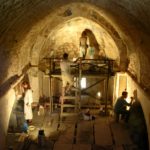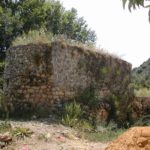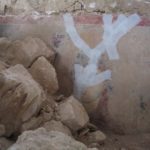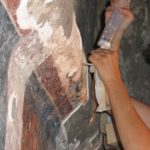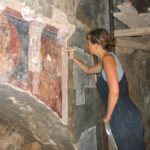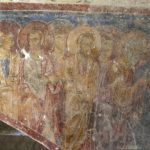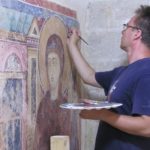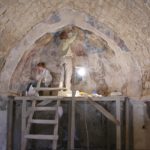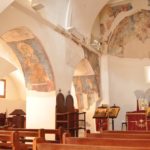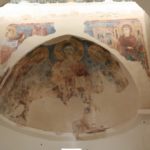Kaftoun
Kaftun
Kaftûn
-
Project name:
Medieval wall paintings in the Church of St Sergius and Bacchus in Kaftoun, Lebanon – conservation and archaeology
-
Type of site:
Church located next to the Greek Orthodox monastery in Kaftoun
Location:
Lebanon, Batroun District
County of Tripoli during the Crusades and the Kingdom of Jerusalem periodDating:
– 13th century
Most interesting finds:
– wall paintings from the second half of the 13th century depicting, among others, Maiestas Domini, the Communion of the Apostles, and warrior saints
– architectural evolution of the Church of St Sergius and Bacchus in the medieval and Ottoman periods
– relics of the early monastic phase of the site discovered under the present-day buildings of the monastery
History of research:
Dates of PCMA mission’s work:
2004–2009
Type of research:
Archaeological and architectural research, conservation work
Directors:
Krzysztof Chmielewski
Tomasz Waliszewski
Co-operating institutions:
– Faculty of Conservation and Restoration of Works of Art of the Academy of Fine Arts in Warsaw
– Polish Centre of Mediterranean Archaeology, University of Warsaw
– Association pour l’Etude et la Restauration des Peintures Médiévales au Liban (Université Saint-Joseph)
– Directorate General of Antiquities of Lebanon
Additional information:
Dumbarton Oaks Research Library and Collection, Trustees for Harvard University, grant for the years 2009–2010: “Forgotten Heritage I. Recording and Publication of the Church of Mar Sarkis and Bakhos in Kaftûn (Lebanon) and its Wall Paintings”; grant holder Tomasz Waliszewski.
Description of the site and research:
The Greek Orthodox monastery in Kaftoun lies at the bottom of a picturesque valley of the River Jawz. Nuns inhabit a monastery building that clings to the side of a high cliff. Despite its modern present-day appearance, its oldest preserved parts date back to the early medieval period. The chapel of the monastery houses the oldest icon in Lebanon – a 13th-century painting on wood depicting the Virgin Mary and Child on the obverse and the Baptism of Christ on the reverse. Next to the monastery stands a small stone church with adjacent outbuildings where remains of mill installations that had been powered by the mountain river were discovered. The three-aisled church with a narthex and a presbytery closed off by an apse was erected in the Crusader period and shows signs of being partly inspired by Western medieval architecture.
With time, the Church of St Sergius and Bacchus fell into ruin, ceased to be used for liturgical purposes, and was abandoned. The north aisle was destroyed, and the weakened outer walls became overgrown. When in 2002 the nuns decided to renovate the church and make it again a place of worship, small fragments of poorly-preserved wall paintings were found during building works. Polish conservators undertook the task of securing this find and examining the interior of the church to see whether there were any other fragments of decoration under the plaster. During the first conservation mission in 2004, damaged but very valuable medieval wall paintings were found in the upper part of the apse. They were uncovered and secured during subsequent seasons and then underwent careful conservation.
Ultimately, of the original decoration of the church, which undoubtedly covered all walls, survived only: a Deesis scene depicting Christ sitting on a throne with the Virgin Mary and St John the Baptist standing on either side of him, a scene of the Annunciation above the apse, two small fragments of a scene of the Communion of the Apostles, a figure of St Lawrence with an angel, and a bust of an archangel in an oval medallion on the walls of the nave, and standing figures of saints in the arcades between the aisles, including the church’s patrons – Sergius and Bacchus. The wall paintings were executed in the fresco technique by applying dry pigments onto wet plaster. They were created in the 13th century in a Byzantine style with local influences. Fragments of preserved inscriptions in three languages – Greek, Old Syriac, and Arabic – attest to this.
Work in the church was conducted until 2009. During that time, the north aisle was rebuilt, the interior was replastered, and the surrounding grounds were tidied up. Today, the church is once again open to worshippers and pilgrims, and the salvaged wall paintings belong to the most valuable ones in the whole region.
Research results:
Season by season – “PCMA Newsletter”:
- 2008 season
- 2007 season
- 2006 season
2016-09 EXHIBITION AND CONFERENCE: People, Places, Monuments. 20 Years of Polish–Lebanese Cooperation in Archaeology and Conservation (1996–2016)
2015-05 Conference on Polish archaeological and conservation work in Lebanon
2014-09 “Forgotten Heritage. Polish Conservators in Lebanon”
2013-09 Gold Cross of Merit for Dr. Mounir Atallah
Waliszewski, T., Chmielewski, K., Immerzeel, M., and Hélou, N. (2013). The Church of Saints Sergius and Bacchus in Kaftun (Northern Lebanon) and Its Wall Paintings. Dumbarton Oaks Papers, 67, 291–322
Waliszewski, T. and Chmielewski, K. (2012). From Byzantine Mosaics to Medieval Paintings. Fifteen Years of Polish-Lebanese Cooperation in Archaeology and Conservation 1996–2011. Beirut: Ambasada RP w Bejrucie
Hélou, N. (2009). Les fresques de Kaftoun au Liban: la cohabitation des deux traditions byzantine et orientale. Chronos, 20, 7–32
Immerzeel, M. (2009). Identity Puzzles. Medieval Christian Art in Syria and Lebanon (=OLA 184) (pp. 94–99, 125–142). Leuven: Peeters
Immerzeel, M. with the co-operation of Nada Hélou (2007). Icon Painting in the County of Tripoli of the Thirteenth Century. In C. Hourihane (ed.), Interactions. Artistic Interchange between the Eastern and Western Worlds in the Medieval Period (=The Index of Christian Art Occasional Papers 9) (pp. 67–83). Princeton
Waliszewski, T., Chmielewski, K. et al. (2007). The Church of Mar Sarkis and Bakhos in Kaftûn and its Wall Paintings. Preliminary Report 2003–2007. Bulletin d’Archéologie et d’Architecture Libanaises, 11, 277–323
Waliszewski, T. and Chmielewski, K. (2005). Kaftoun – Conservation and Restoration of the Mar Sarkis Church Murals, Interim Report. Polish Archaeology in the Mediterranean, 16, 447–452
Gallery:
-
1. The Saydet Kaftoun Monastery in the valley of the Nahr al-Jawz River / Klasztor Saydet Kaftoun w dolinie rzeki Nahr al-Jawz (fot. T. Waliszewski)
-
2. The Church of St Sergius and Bacchus in Kaftoun / Kościół pw. św. Sergiusza i Bachusa w Kaftoun (fot. T. Waliszewski)
-
3. The Church of St Sergius and Bacchus in Kaftoun / Kościół pw. św. Sergiusza i Bachusa w Kaftoun (fot. T. Waliszewski)
-
4. Conservation of wall paintings in the destroyed north aisle of the church / Prace konserwatorskie nad malowidłami w zniszczonej nawie północnej kościoła (fot. T. Waliszewski)
-
5. Depiction of an archangel in the nave of the church / Przedstawienie archanioła w nawie głównej kościoła (fot. T. Waliszewski)
-
6. Depiction of the Virgin Mary in the scene of the Annunciation / Przedstawienie Maryi w scenie Zwiastowania (fot. T. Waliszewski)
-
7. South aisle of the church during conservation and renovation works / Nawa południowa kościoła w trakcie prac konserwatorskich i remontowych (fot. T. Waliszewski)
-
8. Conservation works in the nave of the church / Prace konserwatorskie w nawie głównej kościoła (fot. T. Waliszewski)
-
9. The Church of St Sergius and Bacchus in Kaftoun before conservation and archaeological works / Kościół pw. św. Sergiusza i Bachusa w Kaftoun przed rozpoczęciem prac konserwatorsko-archeologicznych (fot. T. Waliszewski)
-
10. Depiction of the Virgin Mary in the scene of the Annunciation at the time of discovery / Przedstawienie Maryi w scenie Zwiastowania w momencie odkrycia (fot. T. Waliszewski)
-
11. Removing later layers of plaster from the wall paintings in the apse of the church / Usuwanie warstw późnego tynku z malowideł w apsydzie kościoła (fot. T. Waliszewski)
-
12. Interior of the Church of St Sergius and Bacchus in Kaftoun during conservation and archaeological works / Wnętrze kościoła pw. św. Sergiusza i Bachusa w Kaftoun w trakcie prac konserwatorsko-archeologicznych (fot. T. Waliszewski)
-
13. Consolidating the wall paintings / Wzmacnianie podłoża malowideł (fot. T. Waliszewski)
-
14. Cleaning the wall paintings in the nave of the church / Czyszczenie malowideł w nawie głównej kościoła (fot. T. Waliszewski)
-
15. The scene of the Communion of the Apostles in the nave of the church / Przedstawienie sceny Komunii Apostołów w nawie głównej kościoła (fot. T. Waliszewski)
-
16. Professor Krzysztof Chmielewski during the renovation of the Annunciation scene / Prof. Krzysztof Chmielewski podczas restauracji sceny Zwiastowania (fot. T. Waliszewski)
-
17. Interior of the Church of St Sergius and Bacchus in Kaftoun during conservation and archaeological works / Wnętrze kościoła pw. św. św. Sergiusza i Bachusa w Kaftoun w trakcie prac konserwatorsko-archeologicznych (fot. T. Waliszewski)
-
18. Interior of the Church of St Sergius and Bacchus in Kaftoun after conservation and archaeological works / Wnętrze kościoła pw. św. św. Sergiusza i Bachusa w Kaftoun po ukończeniu prac konserwatorskich (fot. T. Waliszewski)
-
19. Decoration of the apse of the church and the scene of the Annunciation after conservation / Dekoracja apsydy kościoła oraz scena Zwiastowania po ukończeniu prac konserwatorskich (fot. T. Waliszewski)

